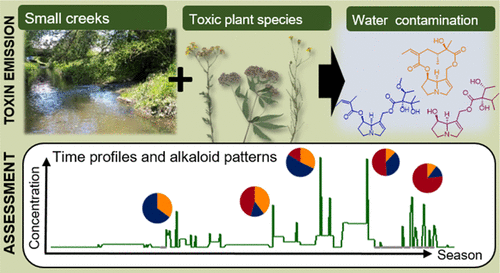当前位置:
X-MOL 学术
›
Environ. Sci. Technol.
›
论文详情
Our official English website, www.x-mol.net, welcomes your
feedback! (Note: you will need to create a separate account there.)
Retrospective HRMS Screening and Dedicated Target Analysis Reveal a Wide Exposure to Pyrrolizidine Alkaloids in Small Streams
Environmental Science & Technology ( IF 10.8 ) Pub Date : 2020-12-29 , DOI: 10.1021/acs.est.0c06411 Barbara F. Günthardt 1, 2 , Felix E. Wettstein 1 , Juliane Hollender 2, 3 , Heinz Singer 3 , Jana Härri 1, 2 , Martin Scheringer 4, 5 , Konrad Hungerbühler 4 , Thomas D. Bucheli 1
Environmental Science & Technology ( IF 10.8 ) Pub Date : 2020-12-29 , DOI: 10.1021/acs.est.0c06411 Barbara F. Günthardt 1, 2 , Felix E. Wettstein 1 , Juliane Hollender 2, 3 , Heinz Singer 3 , Jana Härri 1, 2 , Martin Scheringer 4, 5 , Konrad Hungerbühler 4 , Thomas D. Bucheli 1
Affiliation

|
Pyrrolizidine alkaloids (PAs) are found to be toxic pollutants emitted into the environment by numerous plant species, resulting in contamination. In this article, we investigate the occurrence of PAs in the aquatic environment of small Swiss streams combining two different approaches. Pyrrolizidine alkaloids (PAs) are toxic secondary metabolites produced by numerous plant species. Although they were classified as persistent and mobile and found to be emitted into the environment, their occurrence in surface waters is largely unknown. Therefore, we performed a retrospective data analysis of two extensive HRMS campaigns each covering five small streams in Switzerland over the growing season. All sites were contaminated with up to 12 individual PAs and temporal detection frequencies between 36 and 87%. Individual PAs were in the low ng/L range, but rain-induced maximal total PA concentrations reached almost 100 ng/L in late spring and summer. Through PA patterns in water and plants, several species were tentatively identified as the source of contamination, with Senecio spp. and Echium vulgare being the most important. Additionally, two streams were monitored, and PAs were quantified with a newly developed, faster, and more sensitive LC–MS/MS method to distinguish different plant-based and indirect human PA sources. A distinctly different PA fingerprint in aqueous plant extracts pointed to invasive Senecio inaequidens as the main source of the surface water contamination at these sites. Results indicate that PA loads may increase if invasive species are sufficiently abundant.
中文翻译:

回顾性HRMS筛选和专门的目标分析揭示了小溪中广泛暴露于吡咯烷核生物碱
吡咯烷核生物碱(PAs)被发现是许多植物物种释放到环境中的有毒污染物,造成污染。在本文中,我们结合两种不同的方法研究了瑞士小溪流水生环境中PA的发生。吡咯嗪核生物碱(PAs)是由多种植物产生的有毒次生代谢产物。尽管它们被归类为持久性和可移动性,并发现会排放到环境中,但在地表水中它们的存在很大程度上未知。因此,我们对两个广泛的HRMS活动进行了回顾性数据分析,每个活动涵盖了整个生长季节瑞士的五个小溪流。所有场所均被多达12个单独的PA污染,时间检测频率介于36%和87%之间。个别PA处于低ng / L范围内,但是在春季和夏季末,雨水引起的最大总PA浓度接近100 ng / L。通过水和植物中的PA模式,初步确定了几种物种为污染源,千里光spp。而Echium vulgare是最重要的。此外,监测了两个流,并使用新开发的,更快,更灵敏的LC-MS / MS方法对PA进行了定量,以区分不同的基于植物的和间接的人类PA来源。水生植物提取物中明显不同的PA指纹图谱表明入侵性千里光不饱和菌是这些部位地表水污染的主要来源。结果表明,如果入侵物种足够丰富,PA负载可能会增加。
更新日期:2021-01-19
中文翻译:

回顾性HRMS筛选和专门的目标分析揭示了小溪中广泛暴露于吡咯烷核生物碱
吡咯烷核生物碱(PAs)被发现是许多植物物种释放到环境中的有毒污染物,造成污染。在本文中,我们结合两种不同的方法研究了瑞士小溪流水生环境中PA的发生。吡咯嗪核生物碱(PAs)是由多种植物产生的有毒次生代谢产物。尽管它们被归类为持久性和可移动性,并发现会排放到环境中,但在地表水中它们的存在很大程度上未知。因此,我们对两个广泛的HRMS活动进行了回顾性数据分析,每个活动涵盖了整个生长季节瑞士的五个小溪流。所有场所均被多达12个单独的PA污染,时间检测频率介于36%和87%之间。个别PA处于低ng / L范围内,但是在春季和夏季末,雨水引起的最大总PA浓度接近100 ng / L。通过水和植物中的PA模式,初步确定了几种物种为污染源,千里光spp。而Echium vulgare是最重要的。此外,监测了两个流,并使用新开发的,更快,更灵敏的LC-MS / MS方法对PA进行了定量,以区分不同的基于植物的和间接的人类PA来源。水生植物提取物中明显不同的PA指纹图谱表明入侵性千里光不饱和菌是这些部位地表水污染的主要来源。结果表明,如果入侵物种足够丰富,PA负载可能会增加。











































 京公网安备 11010802027423号
京公网安备 11010802027423号